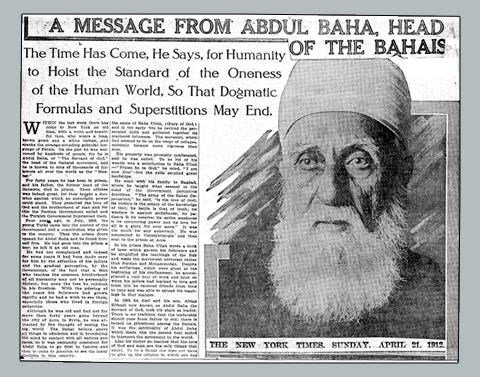|
|
|
Episode 7 September 26, 2021 Walking the Mystical Way with Practical Feet “[In the future] mankind will be as one nation, one race and kind — as waves of one ocean. Although these waves may differ in form and shape, they are waves of the same sea. Flowers may be variegated in colors, but they are all flowers of one garden. Trees differ though they grow in the same orchard. All are nourished and quickened into life by the bounty of the same rain, all grow and develop by the heat and light of the one sun, all are refreshed and exhilarated by the same breeze that they may bring forth varied fruits. This is according to the creative wisdom. If all trees bore the same kind of fruit, it would cease to be delicious. In their never-ending variety man finds enjoyment instead.” — ‘Abdu’l-Bahá  When the S.S. Cedric docked in New York on April 11, 1912, many expectant Bahá’ís awaited on shore for the One whose visit on North American soil had been their dearest wish. Immediately upon setting foot on solid ground, ‘Abdu’l-Bahá was surrounded by a horde of journalists clamouring for His attention. One of them asked: “What do you think of America?” The Master answered “I like it. Americans are optimistic. If you ask them how they are, they say ‘All right!’ If you ask them how things are going, they say ‘All right!’ This cheerful attitude is good.” Fascinated, the press was smitten and would follow Him throughout all His travels. ‘Abdu’l-Bahá’s visit in North America would last 239 days, during which He would meet thousands of people from all walks of life, all temperaments and from all social strata, and of course, with a special love and generous consideration for the poor. He laid out the selfless, straight path that Bahá’ís must follow towards building the Bahá’í Faith both spiritually and administratively, and also laid the cornerstone of the first North American Bahá’í Temple in Chicago on May 1, 1912. To both the Bahá’ís and the broader community He would elucidate on the teachings of Bahá’u’lláh, which included the common thread that connects all the world religions and the need for the unity of humanity and for world peace, which would not take place until humanity reached full gender equality. Among the very many public addresses He gave, ‘Abdu’l-Bahá spoke to the members of the Woman Suffrage Party and their friends about peace and woman suffrage at the Metropolitan Temple in New York. “There is no
difference in
the physical or intellectual value of men
and women. It is only a difference of education which has made an
apparent difference and there will never be universal peace until there
is equal suffrage. If the educator is imperfect, the educated must also
be imperfect — even man. The mother is the first educator of men. If
the mother is imperfect, alas for the condition of men.” |
|
|